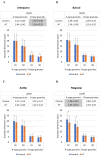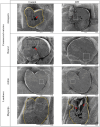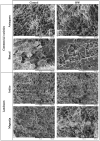Deciphering heat wave effects on wheat grain: focusing on the starch fraction
- PMID: 39711586
- PMCID: PMC11659670
- DOI: 10.3389/fpls.2024.1459283
Deciphering heat wave effects on wheat grain: focusing on the starch fraction
Abstract
Wheat is an essential staple food, and its production and grain quality are affected by extreme temperature events. These effects are even more relevant considering the increasing food demand for a growing world population and the predicted augmented frequency of heat waves. This study investigated the impact of simulated heat wave (HW) conditions imposed during grain filling on starch granule characteristics, endosperm ultrastructure, and transcriptomic modulation of genes involved in starch synthesis and degradation. All these evaluations were performed with four different genotypes, two commercial wheat varieties (Antequera and Bancal), and two traditional landraces (Ardito and Magueija). Starch granule size distribution and shape were significantly altered by HW treatment, revealing an increase of A-type granules in Ardito and an opposite effect in Magueija and Bancal, while Antequera remained stable. Analysis of the largest (LD) and smallest (SD) granule diameters also revealed genotype-specific changes, with Magueija showing a shift toward more spherical A-type granules after the HW treatment. Scanning electron microscopy confirmed alterations in endosperm morphology, including increased vitreousness in Bancal and substantial increase of endosperm cavities and grain size reduction in Magueija under HW stress. The transcriptomic analysis confirmed the stability of Antequera under HW, in contrast with the other genotypes where differential gene expression related to starch metabolism was detected. These effects were particularly severe in Magueija with the downregulation of genes encoding for enzymes involved in amylopectin synthesis (both starch synthases and starch-branching enzyme) and upregulation of α-amylase-encoding genes. These findings contribute to the understanding of heat stress effects on wheat grain quality, emphasize the importance of genetic diversity in HW responses, and suggest potential avenues for breeding climate-resilient wheat varieties.
Keywords: Lugol iodine; RNA sequencing; SEM; bread wheat; endosperm ultrastructure; high temperature; starch granules; transcription.
Copyright © 2024 Pereira, Tomás and Silva.
Conflict of interest statement
The authors declare that the research was conducted in the absence of any commercial or financial relationships that could be construed as a potential conflict of interest.
Figures




Similar articles
-
Grain Transcriptome Dynamics Induced by Heat in Commercial and Traditional Bread Wheat Genotypes.Front Plant Sci. 2022 Jun 17;13:842599. doi: 10.3389/fpls.2022.842599. eCollection 2022. Front Plant Sci. 2022. PMID: 35783979 Free PMC article.
-
Assessment of Four Portuguese Wheat Landrace Diversity to Cope With Global Warming.Front Plant Sci. 2020 Dec 9;11:594977. doi: 10.3389/fpls.2020.594977. eCollection 2020. Front Plant Sci. 2020. PMID: 33362824 Free PMC article.
-
Effects of High Temperature and Drought Stress on the Expression of Gene Encoding Enzymes and the Activity of Key Enzymes Involved in Starch Biosynthesis in Wheat Grains.Front Plant Sci. 2019 Nov 12;10:1414. doi: 10.3389/fpls.2019.01414. eCollection 2019. Front Plant Sci. 2019. PMID: 31798603 Free PMC article.
-
Impact of climate change on wheat grain composition and quality.J Sci Food Agric. 2023 Apr;103(6):2745-2751. doi: 10.1002/jsfa.12289. Epub 2022 Nov 7. J Sci Food Agric. 2023. PMID: 36273267 Review.
-
Understanding Wheat Starch Metabolism in Properties, Environmental Stress Condition, and Molecular Approaches for Value-Added Utilization.Plants (Basel). 2021 Oct 25;10(11):2282. doi: 10.3390/plants10112282. Plants (Basel). 2021. PMID: 34834645 Free PMC article. Review.
References
-
- Barrero J. M., Porfirio L., Hughes T., Chen J., Dillon S., Gubler F., et al. . (2020). Evaluation of the impact of heat on wheat dormancy, late maturity α-amylase and grain size under controlled conditions in diverse germplasm. Sci. Rep. 10, 17800. doi: 10.1038/s41598-020-73707-8 - DOI - PMC - PubMed
-
- Dias A. S., Bagulho A. S., Lidon F. C. (2008). Ultrastructure and biochemical traits of bread and durum wheat grains under heat stress. Braz. J. Plant Physiol. 20, 323–333. doi: 10.1590/s1677-04202008000400008 - DOI
LinkOut - more resources
Full Text Sources
Research Materials

